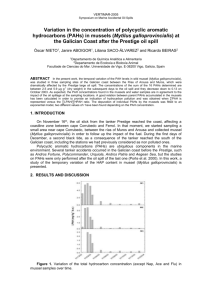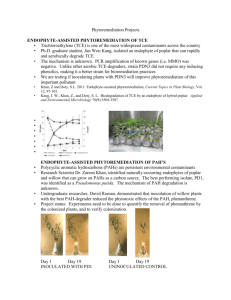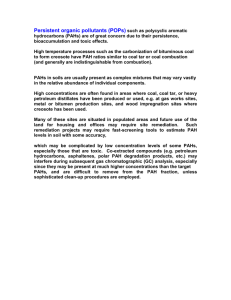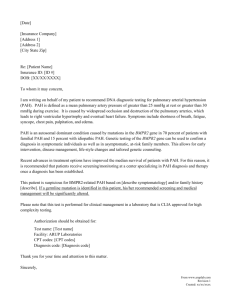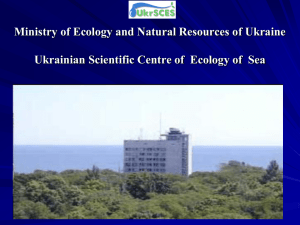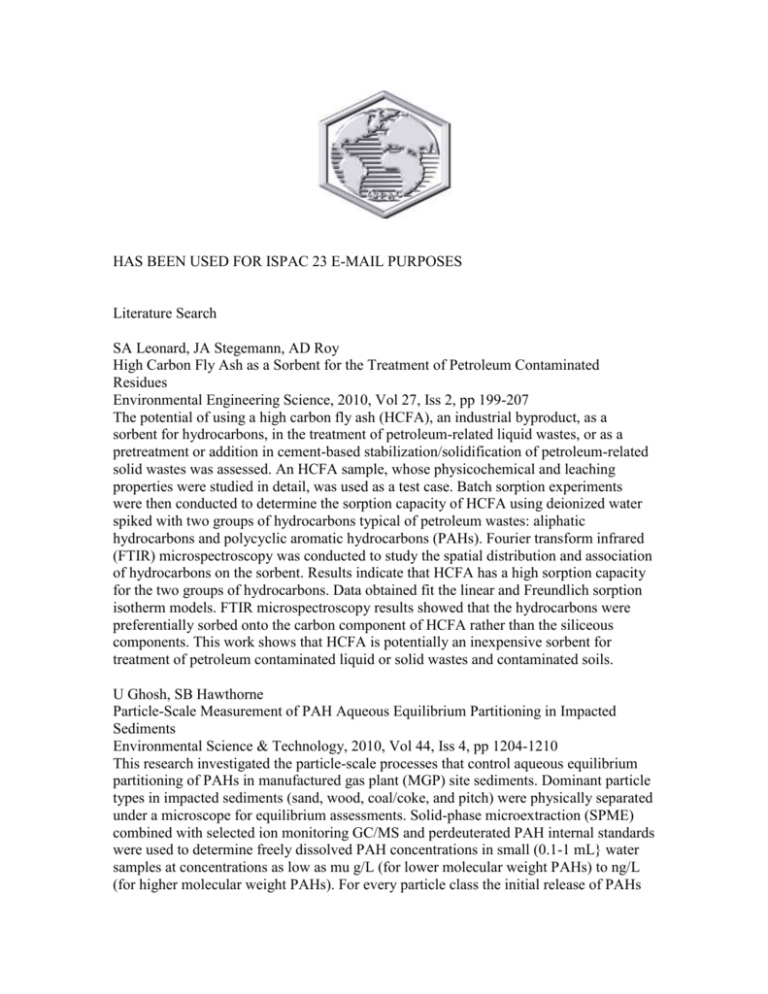
HAS BEEN USED FOR ISPAC 23 E-MAIL PURPOSES
Literature Search
SA Leonard, JA Stegemann, AD Roy
High Carbon Fly Ash as a Sorbent for the Treatment of Petroleum Contaminated
Residues
Environmental Engineering Science, 2010, Vol 27, Iss 2, pp 199-207
The potential of using a high carbon fly ash (HCFA), an industrial byproduct, as a
sorbent for hydrocarbons, in the treatment of petroleum-related liquid wastes, or as a
pretreatment or addition in cement-based stabilization/solidification of petroleum-related
solid wastes was assessed. An HCFA sample, whose physicochemical and leaching
properties were studied in detail, was used as a test case. Batch sorption experiments
were then conducted to determine the sorption capacity of HCFA using deionized water
spiked with two groups of hydrocarbons typical of petroleum wastes: aliphatic
hydrocarbons and polycyclic aromatic hydrocarbons (PAHs). Fourier transform infrared
(FTIR) microspectroscopy was conducted to study the spatial distribution and association
of hydrocarbons on the sorbent. Results indicate that HCFA has a high sorption capacity
for the two groups of hydrocarbons. Data obtained fit the linear and Freundlich sorption
isotherm models. FTIR microspectroscopy results showed that the hydrocarbons were
preferentially sorbed onto the carbon component of HCFA rather than the siliceous
components. This work shows that HCFA is potentially an inexpensive sorbent for
treatment of petroleum contaminated liquid or solid wastes and contaminated soils.
U Ghosh, SB Hawthorne
Particle-Scale Measurement of PAH Aqueous Equilibrium Partitioning in Impacted
Sediments
Environmental Science & Technology, 2010, Vol 44, Iss 4, pp 1204-1210
This research investigated the particle-scale processes that control aqueous equilibrium
partitioning of PAHs in manufactured gas plant (MGP) site sediments. Dominant particle
types in impacted sediments (sand, wood, coal/coke, and pitch) were physically separated
under a microscope for equilibrium assessments. Solid-phase microextraction (SPME)
combined with selected ion monitoring GC/MS and perdeuterated PAH internal standards
were used to determine freely dissolved PAH concentrations in small (0.1-1 mL} water
samples at concentrations as low as mu g/L (for lower molecular weight PAHs) to ng/L
(for higher molecular weight PAHs). For every particle class the initial release of PAHs
into the aqueous phase was rapid, and an apparent equilibrium was reached in a matter of
days. The average ratio of aqueous total PAH concentration for pitch vs coal/coke
particles for eight sediment samples was 20. Thus, sediments that had aged in the field
for many decades were not at equilibrium and were still going through a slow process of
contaminant mass transfer between the different particle types. A possible consequence
of this slow aging process is further lowering of the activity of the chemical as mass
transfer is achieved to new sorption sites with time. This study also found that the
presence of black carbon even at the level of 1/3 of sediment organic carbon does not
necessarily imply a BC-dominated sorption behavior, rather source pitch particles if
present may dominate PAH partitioning. To our knowledge this is the first report of
equilibrium partitioning assessment conducted at the sediment particle scale.
J Rozemeijer, Y vanderVelde, H deJonge, F vanGeer, HP Broers, M Bierkens
Title Application and Evaluation of a New Passive Sampler for Measuring Average
Solute Concentrations in a Catchment Scale Water Quality Monitoring Study
Full source
Environmental Science & Technology, 2010, Vol 44, Iss 4, pp 1353-1359
Address
Rozemeijer J, Univ Utrecht, Dept Phys Geog, POB 80125, NL-3508 TC
Utrecht, NETHERLANDS
Abstract
We present a field based testing, optimization, and evaluation study of the
SorbiCell sampler (SC-sampler); a new passive sampling technique that measures
average concentrations over longer periods of time (days to months) for various
substances. We tested the SC-sampler within a catchment-scale monitoring study of NO3
and P concentrations in surface water and the drain effluent. Based on our field
experiences, we optimized the flow velocity control and the sample volume capacity of
the SC-samplers. The SC-samplers were capable of reproducing the NO3 concentration
levels and the seasonal patterns that were observed with weekly conventional grab
sampling and continuous water quality measurements. Furthermore, we demonstrated
that average measurements produce more consistent load estimates than ''snapshot''
concentrations from grab sampling. Therefore, when the purpose of a monitoring
program is to estimate reliable (trends in) average concentrations or loads, the SCsamplers are a cost-effective alternative for grab sampling.
B Janoszka
Heterocyclic amines and azaarenes in pan-fried meat and its gravy fried without additives
and in the presence of onion and garlic
Food Chemistry, 2010, Vol 120, Iss 2, pp 463-473
The effect of onion and garlic on the formation of heterocyclic amines (HAs,
aminoazaarenes) and azaarenes (aza-PAHs) was evaluated by comparing the
concentrations of several compounds in meat and gravy samples, obtained from three
pork dishes prepared in the presence and absence of these spices. The concentrations of
individual HAs (8-MeIQx, MeIQ, 4,8-DiMeIQx, PhIP) were from 0.5 ng g(-1) to 10.5 ng
g(-1) of meat and of azaarenes (benzo[a]acridine, benzo[c]acridine, dibenzo[a,c]acridine,
dibenzo[a j]acridine and dibenzo[a,h]acridine) - from 0.06 ng g(-1) to 0.99 ng g(-1). The
addition of onion (30 g/100 g of meat) in the dishes investigated, caused a decrease in
heterocyclic amines concentration (considering total contents in meat and gravy) in the
range of 31-49% and of azaarenes by 21-48%. Garlic (15 g/100 g of meat) lowered the
concentration of HAs by 26-36% and azaarenes by 33-40%; the changes in
concentrations caused by these spices were different for particular compounds.
Components of onion and garlic intensify the extraction of heterocyclic amines and
azaarenes from meat in gravy,
HB Gu, XD Wang, CL Bai, XJ Chen, RL Tanguay, QX Dong, CJ Huang
PHENANTHRENE AND FLUORENE-MEDIATED EARLY DEVELOPMENTAL
TOXICITY IN ZEBRAFISH
Fresenius Environmental Bulletin, 2010, Vol 19, Iss 1, pp 57-62
The early developmental toxicity in zebrafish exposed by Phenanthrene (Phe) and
Fluorene (Fl) was investigated by determining mortality and morphological malformation
endpoints, such as no inflation of swimming bladder (no ISB), axial malformations (AM,
crooked/clubbed), pericardial edema (PE) and yolk sac edema (YSE). The lethal
concentration to cause 50% mortality (LC50) in embryos was 78.632 mu mol L-1 for Phe
and 236.930 mu mol L-1 for Fl, respectively. Embryos exposed to 40 mu mol L-1 Phe
exhibited a reduction of blood stream speed and sharply increasing of axial malformation
rate. When exposed to 80 mu mol L-1 Phe, the significant (at p<0.05) increase of PE or
YSE index was observed. Embryos exposed to Fl had significant axial malformations, but
didn't cause significant PE, YSE and speed reduction of blood stream as those exposed to
Phe. The joint effect of Phe and Fl was antagonistic. The 42-h and 114-h Phe-exposure
results showed similar mortality and malformation rates. All of the toxic endpoints
showed the significant differences (p<0.05) between 18-h and 114-h exposure, suggesting
that 42-h exposure produced very serious and irreversible toxicological effects, but that
18-h Phe-exposure only generated slight, reversible toxic effects. At low concentrations
(3.12-12.5 mu mol L-1) of Phe producing no obviously morphological abnormality or
mortality, the locomotion analysis on the larval zebrafish showed that Phe-exposed
groups have significantly (p<0.05) higher speed movements (>15 mm/s) than control
groups.
UM Sofowote, LM Allan, BE McCarry
Evaluation of PAH diagnostic ratios as source apportionment tools for air particulates
collected in an urban-industrial environment
Journal of Environmental Monitoring, 2010, Vol 12, Iss 2, pp 417-424
A variety of polycyclic aromatic hydrocarbon (PAH) diagnostic ratios were examined as
source apportionment tools in the analysis of a PAH data set associated with atmospheric
particulate matter collected in an urban-industrial environment. Seventy-six PM10
samples were collected concurrently at 4 sampling sites over a one-month period in
Hamilton, Ontario, Canada, a city of 500 000 people that is home to two integrated steel
companies, associated industries and a network of roadways and major highways.
Samples collected under well defined meteorological conditions were categorized as
being 'upwind' or 'downwind' of the industrial sector. All sample extracts were analyzed
for 48 parent PAH, methylphenanthrenes and sulfur-containing aromatics and showed a
thousand-fold range of total PAH concentrations (0.23-172 ng m(-3)). Of all PAH
diagnostic ratios examined, the two most useful were the
anthracene/(anthracene+phenanthrene) and benz[a]anthracene/(benz[a]
anthracene+chrysene/triphenylene) ratios. These afforded the best discrimination of
samples that had significant industrial impacts. This work is the first example of the use
of a linear combination of PAH ratios, coupled with total PAH data and well defined
local samples to determine the relative impacts of mobile and industrial emissions in an
urban-industrial environment. Use of a linear combination of PAH ratios allowed us to
categorize 95% of the data as 'upwind' or 'downwind' of the industrial sector. It is
important to determine PAH ratio threshold values based on data from well defined local
samples rather than relying on literature values alone.
N Ozaki, N Takemoto, T
Nitro-PAHs and PAHs in Atmospheric Particulate Matters and Sea Sediments in
Hiroshima Bay Area, Japan
Water Air and Soil Pollution, 2010, Vol 207, Iss 1-4, pp 263-271
Atmospheric and sea sediment concentrations were measured for eight nitrated polycyclic
aromatic hydrocarbons (nitro-PAHs) and three unsubstituted PAHs in a suburban area
and sea sediments in the Hiroshima Bay watershed area, Japan, from July to December,
2006 (atmospheric particulate matter) and in September and November, 2004 (sea
sediments). Atmospheric concentration was higher in winter than summer for both nitroPAHs and PAHs. Concentrations in sea sediments were less than 10%, and pattern was
similar to those of atmospheric particles. Several combustion emission sources were also
measured, and the 1-NP/Pyr ratio was compared to environmental values. The ratio of
atmospheric and sea sediments were significantly lower than diesel particulate matters.
Further, the vehicle emission loading and sea sedimentation loading was evaluated in this
watershed area, and from the comparison, the existence of other important sources PAHs
were suggested.
AK Kumar, P Vatsyayan, P Goswami
Production of Lipid and Fatty Acids during Growth of Aspergillus terreus on
Hydrocarbon Substrates
Applied Biochemistry and Biotechnology, 2010, Vol 160, Iss 5, pp 1293-1300
An Aspergillus terreus, isolated from oil contaminated soil, could degrade a wide range
of petroleum hydrocarbons including the immediate oxidation products of hydrocarbons,
like alkanols and alkanals. Among all the linear chain carbon substrates, highest growth
of 39.1 +/- 3.8 g l(-1) (wet weight) was observed when n-hexadecane was used as the sole
source of carbon. The growth of the fungus on this highly hydrophobic substrate was
associated with the morphological change of the hyphae and increase production of lipid
in the cells. The lipid production in the hydrocarbon (n-hexadecane) grown cells was
sevenfold higher than the corresponding glucose grown cells. The fatty acid profile of the
lipid content formed in the hydrocarbon grown cells was significantly different from the
glucose grown cells and was composed of fatty acids with chain length C-14 to C-33 as
revealed from the liquid chromatography electrospray ionization mass spectrometry
analyses. Among the ranges, the fatty acids with chain lengths C-14 to C-18 were
predominant in the profile. Considering the fatty acid profile and the high level of lipid
production, this A. Terreus mediated production of lipid is envisaged to have potential
application in the oleochemical industries including the production of biodiesel.
JH Su, JH Xu, ZL Wang
Improving Enzymatic Production of Ginsenoside Rh-2 from Rg(3) by using Nonionic
Surfactant
Applied Biochemistry and Biotechnology, 2010, Vol 160, Iss 4, pp 1116-1123
In this study, several nonionic surfactants were tried to improve the enzymatic hydrolysis
of ginsenoside Rg(3) into Rh-2 which was catalyzed at 50 degrees C and pH 5.0 by a
crude glucosidase extracted from Fusarium sp. ECU2042. Among the biocompatible
nonionic surfactants, polyethylene glycol 350 monomethyl ether was shown to be the
best. After optimizing some influencing factors on the reaction, the conversion of Rg(3)
(5 g/l) with 10 g/l crude enzyme reached almost 100% in the presence of the nonionic
surfactant (7.5%, w/v), which was 25% higher than that in buffer without any surfactant.
Furthermore, the enzyme stability was affected faintly by the surfactant.
AH Nudi, ADR Wagener, E Francioni, CB Sette, AV Sartori, AD Scofield
Biomarkers of PAHs exposure in crabs Ucides cordatus: Laboratory assay and field study
Environmental Research, 2010, Vol 110, Iss 2, pp 137-145
Pyrene metabolites in urine and micronucleus in haemocytes of crabs (Ucides cordatus)
were tested as biomarkers of exposure to oil derived PAHs in mangrove sediments. The
goal was to verify how well pyrene metabolites in urine represent levels of oil
contamination in mangroves and whether the micronuclei assay indicates exposure. For
this, bioassays were performed using crabs from clean and contaminated areas, and field
studies were conducted in four mangroves. Results of the bioassay show that U. Cordatus
assimilates, metabolises, and excretes pyrene in urine as pyrene-l-glucoside, pyrenesulphate and pyrene-conjugate. OH-pyrene-sulphate was the major metabolite
produced/excreted over 120 h of observation by crabs from the clean mangrove. The
production/excretion of pyrene-1-glucoside in this case increased linearly with time at a
rate of 2.3 x 10(-10) mol L-1 day(-1). The number of micronuclei in haemocytes also
increased with the time after pyrene inoculation, indicating that exposure to pyrene
triggers genotoxic and mutagenic response. In crabs from a heavily oil-contaminated
mangrove pyrene-1-glucoside was the major metabolite, an indication that
production/excretion of a certain metabolite varies depending on adaptation of the animal
to the environment. A highly significant correlation was found between the concentration
of pyrene metabolites in urine of field crabs expressed as OH-pyrene equivalents and the
sum of 38 PAHs determined in hepatopancreas/sediments (r=0.825, n=23, p < 0.05). The
response of these crabs to the micronuclei assay was not significantly related to
concentration of individual or total PAHs. Nevertheless, metabolite results prove U.
Cordatus as excellent bioindicator for evaluating environmental quality in mangrove
areas as related to PAHs and oil contamination. (C) 2009 Elsevier Inc.
C Meinert, W Brack
Optimisation of trapping parameters in preparative capillary gas chromatography for the
application in effect-directed analysis
Chemosphere, 2010, Vol 78, Iss 4, pp 416-422
Preparative capillary gas chromatography (pcGC) provides novel high resolution
fractionation opportunities in effect-directed analysis. However, harvesting efficiency
strongly depends on the operating parameters of the system. Therefore, the performance
of the pcGC system was optimised by identifying the best operating parameters for the
preparative fraction collector (PFC) using six test analytes with different physicochemical
properties. The present study indicates that pcGC parameters need to be selected
individually for the investigated analytes. The major focus was put on the trapping
parameters as published findings on optimum trapping conditions are very variable. No
generally agreed concept is available. An alternative to temperature-controlled trapping
are solvent-filled traps. The solvent dichloromethane (DCM) proved to be most suitable
for a large range of compounds. Recoveries are equal to optimised dry trapping at defined
temperature. Optimised recoveries were in the range of 50-70% for all compounds except
benzo[a]pyrene with a recovery of 94% using one PFC and DCM-filled traps at trapping
temperature of -10 degrees C, at PFC temperatures of 300 degrees C for phenol, 400
degrees C for benzolalpyrene and 320 degrees C for the remaining analytes.
S Hyun, M Kim, K Baek, LS Lee
Phenanthrene and 2,2',5,5'-PCB sorption by several soils from methanol-water solutions:
The effect of weathering and solute structure
Chemosphere, 2010, Vol 78, Iss 4, pp 423-429
The effect of the sorption of phenanthrene and 2,2',5,5'-polychlorinated biphenyl
(PCB52) by five differently weathered soils were measured in water and low methanol
volume fraction (f(c) <= 0.5) as a function of the apparent solution pH (pH(app)). Two
weathered oxisols (A2 and DRC), and moderately weathered alfisols (Toronto) and two
young soils (K5 and Webster) were used. The K-m (linear sorption coefficient) values,
which log-linearly decreases with f(c), were interpreted using a cosolvency sorption
model. For phenanthrene sorption at the natural pH, the empirical constant (alpha) ranged
between 0.95 and 1.14. And was in the order of oxisols (A2 and DRC) < alfisols
(Toronto) < young soils (K5 and Webster). Smaller alpha values for highly weathered
soils are indicative of smaller solute sorption reduction than those predicted from the
increment of the solute's activity coefficient in the solution phase. A similar trend was
observed for PCB52 sorption. The K-m values measured at the range of pH 3-7 also
showed an inversely log-linear relationship. The regression slope (alpha sigma)
calculated from the cosolvency sorption model as a function of PHapp only varied within
<5%, with the exception for phenanthrene sorption by two highly weathered soils, which
had 10% greater alpha sigma values obtained at acidic pH(app). This phenomenon is a
result of the greater acid enhancement effect on phenanthrene sorption by the oxisols,
which is reduced with increasing f(c). These results revealed an unexplored relationship
between the cosolvent effect on the sorption and the properties of the soil organic matter
(a primary sorption domain) as a function of the degree of soil weathering.
W Jiang, JJ Wang, JS Tang, F Hou, YT Lu
Soil bacterial functional diversity as influenced by cadmium, phenanthrene and degrade
bacteria application
Environmental Earth Sciences, 2010, Vol 59, Iss 8, pp 1717-1722
There are increasing concerns over compound pollution in northeast of China and its
bioremediation. Cd, Phe, degradation bacteria W.J and their combination on soil
microbial community function were assessed with the BIOLOG method. The microbial
community was extracted from the soil with different treatments. Average color
development, richness, Shannon-Weaver index, and principal component analysis on OD
standardized data were performed. The results showed that soil microbial metabolic
diversity in CK was significantly higher than that in the soils in which Cd, Phe, W.J or
their combination was added. It indicated that Cd, Phe has significantly negative effect on
the sole-carbon-source metabolic ability of soil microbial communities, particularly when
both of them were present. Application of degradation bacteria incubation makes soil
microbial communities same as control except for the significant decrease in 4-hydroxy
benzoic acid, L-serine, glucose-1-phosphate metabolism. It shows that the incubate
application has a considerably effect in soil communities reversion.
JE Weinstein, KD Crawford, TR Garner
Polycyclic aromatic hydrocarbon contamination in stormwater detention pond sediments
in coastal South Carolina
Environmental Monitoring and Assessment, 2010, Vol 162, Iss 1-4, pp 21-35
The purpose of this study was to characterize the PAH contamination in the sediments of
stormwater detention ponds in coastal South Carolina. Levels of the sum of PAH analytes
were significantly higher in the sediments of commercial ponds compared to that of
reference, golf course, low-density residential, and high-density residential ponds. Isomer
ratio analysis suggested that the predominant source of PAHs were pyrogenic; however,
many ponds had a PAH signature consistent with mixed uncombusted and combusted
PAH sources. PAH levels in these sediments could be modeled using both pond drainage
area and pond surface area. These results demonstrate that the sediment from most
commercial ponds, and a few residential and golf course ponds, were moderately
contaminated with PAHs. PAH levels in these contaminated ponds exceeded between
42% and 75% of the ecological screening values for individual PAH analytes established
by US EPA Region IV, suggesting that they may pose a toxicological risk to wildlife.
SS Cindoruk, Y Tasdemir
Dynamics of atmospheric polychlorinated biphenyls (PCBs): concentrations, patterns,
partitioning, and dry deposition level estimations in a residential site of Turkey
Environmental Monitoring and Assessment, 2010, Vol 162, Iss 1-4, pp 67-80
Air samples were collected at a residential site (Gulbahce, Bursa, Turkey) between
August 2004 and April 2005 using a modified high volume air sampler. The mean of gas
and particle phase concentrations of polychlorinated biphenyls (PCBs) were 468 +/-297
and 43 +/-37 pgm(-3) (average +/-standard deviation, SD), respectively. The dominated
PCB homologs were 3-CBs, 4-CBs, and 5-CBs. The measured PCB concentrations were
higher than the values of pristine sites. In order to assess the gas/particle partitioning fate,
log K-P-log P-L(o), log KP-log K-OA and the Junge-Pankow model were applied to the
data. Experimental K-P was well correlated with log P-L(o) and log K-OA at p < 0.05.
Then, dry deposition fluxes were estimated using atmospheric concentrations and dry
deposition velocities obtained from literature. A correlation matrix was formed for PCB
homologs including 27 congeners with concurrently measured 16 polycyclic aromatic
hydrocarbons (PAHs) and meteorological parameters. Most of PAH compounds were
significantly correlated with 5-CBs and 6-CBs.
L SalazarCoria, I Schifter, C GonzalezMacias
Weighing the evidence of ecological risk from PAHs contamination in the estuarine
environment of Salina Cruz Bay, M,xico
Environmental Monitoring and Assessment, 2010, Vol 162, Iss 1-4, pp 387-406
Results of bulk-phase chemical measurements, toxicological tests combined with
bioaccumulation measures in fishes, were used to evaluate the toxicity of the 16 USEPA
priority polycyclic aromatic hydrocarbons from the sediment collected from eight stations
of the Ventosa Estuarine System, located close to the main center of processing oil in the
Mexican Pacific coast. Levels of the sum of polycyclic aromatic hydrocarbons varied
from 22 to 6,850 mu g kg (-aEuro parts per thousand 1) dry weight. Based on sediment
quality guidelines, the compounds with high environmental priority were acenaphtylene,
acenaphtene, and phenanthrene. Acute toxicity tests with Vibrio fischeri and Daphnia
magna as well as chronic toxicity with Panagrellus redivivus were performed. The
quantification of hepatic ethoxyresorufin O-deethylase activity was used to assess the
induction of the mixed function oxygenase system of brown trout. However, because it is
often difficult to blend the results from such very different assays into a unified decision
about the potential for impacts, a weight-of-evidence (WOE) approach to sediment
quality investigations was followed. These assays provided measurement endpoints that
could be used to develop an overall evaluation of the potential for environmental impacts
from the oil processing operations. WOE provides a valuable tool for assessing the results
of environmental investigations because it provides a framework for considering the
strengths and weaknesses of environmental measurements, an approach for addressing
uncertainty in the measurements, and documentation of the evaluation and its
assumptions.
S Augusto, C Maguas, J Matos, MJ Pereira, C Branquinho
Lichens as an integrating tool for monitoring PAH atmospheric deposition: A comparison
with soil, air and pine needles
Environmental Pollution, 2010, Vol 158, Iss 2, pp 483-489
The aim of this study was to validate lichens as biomonitors of PAH atmospheric
deposition: for that, an inter-comparison between the PAH profile and concentrations
intercepted in lichens with those of air, soil and pine needles was performed. The study
was conducted in a petro-industrial area and the results showed that PAH profiles in
lichens were similar to those of the air and pine needles, but completely different from
those of soils. Lichens accumulated higher PAH concentrations when compared to the
other environmental compartments and its concentrations were significantly and linearly
correlated with concentrations of PAHs in soil; we showed that a translation of the lichen
PAHs concentrations into regulatory standards is possible, fulfilling one of the most
important requirements of using lichens as biomonitors. With lichens we were then able
to characterize the air PAHs profile of urban, petro-industrial and background areas. (C)
2009 Elsevier Ltd. All rights reserved.
Record 96 of 167
WX Liu, SS Xu, BS Xing, B Pan, S Tao
Nonlinear binding of phenanthrene to the extracted fulvic acid fraction in soil in
comparison with other organic matter fractions and to the whole soil sample
Environmental Pollution, 2010, Vol 158, Iss 2, pp 566-575
Fractions of soil organic matter in a natural soil were extracted and sorption (or binding)
characteristics of phenanthrene on each fraction and to the whole sample were
investigated. The organic carbon normalized single point sorption (or binding) coefficient
followed lipid > humin (HM) > humic acid (HA) > fulvic acid (FA) > whole soil sample,
while the nonlinear exponent exhibited lipid > FA > HA > whole soil sample > HM. FA
showed nonlinear binding of phenanthrene as it often does with other fractions. HM and
HA contributed the majority of organic carbon in the soil. The calculated sorption
coefficients of the whole soil were about two times greater than the measured values at
different equilibrium phenanthrene concentrations. As for phenanthrene, the sorption
capacity and nonlinearity of the physically mixed HA-HM mixtures were stronger as
compared to the chemically reconstituted HA-HM composite. This was attributed
to(besides the conditioning effect of the organic solvents) interactions between HA and
HM and acid-base additions during fractionation.
AL Juhasz, E Smith, N Waller, R Stewart, J Weber
Bioavailability of residual polycyclic aromatic hydrocarbons following enhanced natural
attenuation of creosote-contaminated soil
Environmental Pollution, 2010, Vol 158, Iss 2, pp 585-591
The impact of residual PAHs (2250 +/- 71 mu g total PAHs g(-1)) following enhanced
natural attenuation (ENA) of creosote-contaminated soil (7767 +/- 1286 mu g total PAHs
g(-1)) was assessed using a variety of ecological assays. Microtox (TM) results for
aqueous soil extracts indicated that there was no significant difference in EC50 values for
uncontaminated, pre- and post-remediated soil. However, in studies conducted with
Eisenia fetida, PAH bioaccumulation was reduced by up to 6.5-fold as a result of ENA.
Similarly, Beta vulgaris L biomass yields were increased 2.1-fold following ENA of
creosote-contaminated soil. While earthworm and plant assays indicated that PAH
bioavailability was reduced following ENA, the residual PAH fraction still exerted
toxicological impacts on both receptors. Results from this study highlight that residual
PAHs following ENA (presumably non-bioavailable to bioremediation) may still be
bioavailable to important receptor organisms such as earthworms and plants.
LD Sabin, KA Maruya, WJ Lao, D Diehl, D Tsukada, KD Stolzenbach, KC Schiff
EXCHANGE OF POLYCYCLIC AROMATIC HYDROCARBONS AMONG THE
ATMOSPHERE, WATER, AND SEDIMENT IN COASTAL EMBAYMENTS OF
SOUTHERN CALIFORNIA, USA
Environmental Toxicology and Chemistry, 2010, Vol 29, Iss 2, pp 265-274
The present study investigated cross-media transport between both the sediment and the
water column and between the water column and the atmosphere, to understand the role
of each compartment as a source or a sink of PAHs in southern California, USA, coastal
waters. Concentrations of PAH were measured in the atmosphere, water column, and
sediment at four water-quality-impaired sites in southern California: Ballona Creek
Estuary, Los Angeles Harbor, Upper Newport Bay, and San Diego Bay. These
concentrations were used to calculate site-specific sediment-water and atmosphere-water
exchange fluxes. The net sediment-water exchange of total PAH (t-PAH) was positive,
indicating that sediments were a source to the overlying water column. Furthermore, the
net atmosphere-water exchange (gas exchange + dry particle deposition) of t-PAH was
typically positive also, indicating the water column was a net source of PAH to the
surrounding atmosphere through gas exchange. However, in all cases, the magnitude of
the diffusive flux of PAH out of the sediments and into the water column far exceeded
input or output of PAH through air/water exchange processes. These results demonstrate
the potential importance of contaminated sediments as a source of PAH to the water
column in coastal waters of southern California.
YJ Feng, QF Sun, P Gao, NQ Ren, ZH Zhang
POLYCYCLIC AROMATIC HYDROCARBONS IN SURFACE WATER FROM THE
SONGHUA RIVER OF CHINA
Fresenius Environmental Bulletin, 2009, Vol 18, Iss 12, pp 2388-2395
The concentrations of 8 polycyclic aromatic hydrocarbons (PAHs) in water samples
collected from 10 stations in Songhua River, China were analyzed. Molecular ratios were
used to characterize the possible pollution sources. The mean concentrations of PAHs
were 3.44, 4.17 and 0.53 mu g.L-1 in January, February and May 2007. Naphthalene was
the dominant species in water samples with mean values of 1.57, 1.29 and 0.15 mu g.L-1,
and with relative proportions of 43.77%, 30.90% and 28.62% in these 3 months,
respectively. Higher concentrations of PAHs were found in sampling stations S1, S2, S5,
S7, and S9 during lowflow period (January and February) than mean-flow period (May).
Ratios of anthracene/(anthracene+ phenanthrene) and fluoranthene/(fluoranthene+pyrene)
were calculated to evaluate the possible sources of PAH contaminations. These ratios
reflect inputs of PAHs from combustion sources, especially from those of grass, wood
and coal.
WL Ho, TC Lin, YY Liu, JA Chen
Analysis of smoke PAHs from selected Taiwanese cigarettes by using molecular
imprinting polymers
Journal of Environmental Science and Health Part A - Toxic/Hazardous Substances &
Environmental Engineering, 2010, Vol 45, Iss 2, pp 211-223
PAHs and their derivatives are common trace pollutants produced during incomplete
combustion of organic substances, such as tobacco. After sampling cigarette smoke, PAH
collators must undergo pretreatment processes such as extraction, cleanup and
concentration before instrument analysis. This study combines molecular imprinted
polymers (MIPs) and solid-phase extraction (SPE) to create a novel sample pretreatment
technique. Experimental results demonstrate that MIPs have good selectivity for benz[a]
pyrene (BaP) from a mixture of 16 PAH solvents. The MIPs were applied to a sample
taken from mainstream smoke from a cigarette. Based on functional monomers and
crosslinkers, this study investigated two groups of MIPs. After the template was
removed, various tests, including capacity, selectivity, recovery, scanning electron
microscope (SEM) observations and real environmental sample tests, were conducted.
Experimental results show that MIP-1 is the best MIP, with a capacity of 20.78 +/- 1.7
(mu g/g), BaP selectivity and recovery exceeding 93%. In environmental sample tests,
i.e., mainstream smoke from S and M brand cigarettes, 80% of BaP was absorbed by the
MIP compared with absorbed by the filters. All experimental results suggest that MIPs
effectively adsorbed BaP among 16 different PAHs, reduced background interference and
increased signal resolution compared with traditional extraction techniques. Additionally,
using MIPs for sample pretreatment is less time-consuming than traditional sample
pretreatments and also reduces the amount of organic solvent used. Using molecular
imprinted polymers solid extraction (MISPE) may separate target analytes from a
complex sample more effectively than traditional Soxhlet extraction. Future toxicity tests
should contribute to the understanding of toxic compounds emitted from specific
pollution sources.
MC GonzalezLozano, LC MendezRodriguez, AM MaedaMartinez, G Murugan, A
VazquezBotello
Evaluation of toxicity of polluted marine sediments from Bahia Salina Cruz, Mexico
Journal of Environmental Science and Health Part A - Toxic/Hazardous Substances &
Environmental Engineering, 2010, Vol 45, Iss 1, Sp. Iss. SI, pp 121-127
Bahia Salina Cruz, Oaxaca, Mexico is a major center of oil and refined product
distribution on the Mexican Pacific coast. From the start of oil industry operations in
1979, negative effects from discharges of treated effluents in the bay have been a
constant concern for local communities. We analyzed 28 surface sediment samples
obtained in June, 2002 to evaluate the level of toxicity in the littoral zone, port-harbor,
and La Ventosa estuary in Bahia Salina Cruz. The extractable organic matter
concentration was high (1213 to 7505 mu g g(-1)) in 5 of 7 stations from the port and
harbor, whereas it was low in 12 of 16 stations in the littoral zone (36 to 98 mu g g(-1)).
The total aromatic hydrocarbon concentration was highest (57 to 142 mu g g(-1)) in the
port and harbor compared to the La Ventosa estuary and the littoral zone. Among the
heavy metals analyzed, cadmium exceeded the effects range-low values associated with
adverse biological effects. The geo-accumulation index of sediments was moderate to
strong contamination at 5 stations in the nonlittoral and 6 stations in the littoral zone. The
enrichment of lead, zinc, and cadmium at 5 stations from the littoral, port, and harbor
suggest that these metals are of anthropogenic origin. Bioassay tests of elutriates of
sediments on nauplii of Artemia franciscana and Artemia sp. Showed that the port and
harbor were more toxic than the La Ventosa estuary and the coastal zone. The Microtox
test (Vibrio fischeri) did not show a similar response with the solid phase of the
sediments. The results of this study indicate that the high levels of organic content and
metals in the sediments of port-harbor and the La Ventosa estuary are mainly caused by
anthropogenic activities.
WF Sedik, KE Dempsey, X Meng, JA Craft
Temporal expression of sex-specific genes in the mantle of the common mussel (Mytilus
edulis)
Marine Biology, 2010, Vol 157, Iss 3, pp 639-646
A qPCR assay was developed to measure expression of male-specific vitelline coat lysin
(VCL) and female-specific vitelline envelop receptor for lysin (VERL) in the mantle of
Mytilus edulis, the common mussel. The ability of the method to correctly assign sex was
validated by a combination of histology and a previously developed end-point RT-PCR
for these transcripts (Hines et al. 2007). Mussels used were collected over a 21-month
period, and sex could be assigned by qPCR in > 90% of the animals including at times of
the year when the animals were 'spent' or were rebuilding gonads. In the previous and this
study, some individual animals appeared to produce both VCL and VERL transcripts
when measured by the RT-PCR method, but the qPCR assay showed that in the majority
of such animals, only one transcript was present at appreciable quantity. However, in a
few animals (similar to 3%), equal amounts of each were found but the significance of
this observation requires further study. VCL and VERL transcripts were low in the initial
samples of October 2006 but increased to a maximum at March 2007 before decreasing
again rapidly to a minimum in June 2007 before increasing again in October 2007. In a
second, shorter sequence of sampling another maxima was found in March 2008 and a
minima by June 2008. Although both transcripts reached a peak at the same time, it
seems that VCL appears, accumulates and disappears in a narrower time-window than
does VERL. This may relate to the higher energy costs of building eggs than sperm.
L Ciric, JC Philp, AS Whiteley
Hydrocarbon utilization within a diesel-degrading bacterial consortium
FEMS Microbiology Letters, 2010, Vol 303, Iss 2, pp 116-122
Diesel fuel is a common environmental pollutant comprised of a large number of both
aromatic and aliphatic hydrocarbons. The microbial degradation of individual
hydrocarbons has been well characterized, however, the community dynamics within a
system degrading a complex pollutant such as diesel fuel are still poorly understood. The
growth capabilities of a diesel-degrading consortium, along with organisms isolated from
a contaminated site, were investigated using molecular profiling, isolation, and
physiological methods using 10 of the fuel's most abundant constituents as sole carbon
sources. The results indicated that the degradation of the fuel's constituents may be
shared among the diverse microbial community. Some organisms were capable of growth
on the majority of the hydrocarbons tested, whereas others seemed specialized to only a
few of the substrates.
X Tekpli, E Rivedal, M Gorria, NE Landvik, M Rissel, MT DimancheBoitrel, G Baffet,
JA Holme, D LagadicGossmann
The B[a]P-increased intercellular communication via translocation of connexin-93 into
gap junctions reduces apoptosis
Toxicology and Applied Pharmacology, 2010, Vol 242, Iss 2, pp 231-240
Gap junctions are channels in plasma membrane composed of proteins called connexins.
These channels are organized in special domains between cells, anti provide for direct
gap junctional intercellular communication (GJIC), allowing diffusion of signalling
molecules <1 kD. GJIC regulates cell homeostasis and notably the balance between
proliferation, cell cycle arrest, cell survival and apoptosis. Here, we have investigated
benzo[a]pyrene (B[a]P) effects on GJIC and on the subcellular localization of the major
protein of gap junction: connexin-43 (Cx43). Our results showed that B[a]P increased
GJIC between mouse hepatoma Hepa1c1c7 cells via translocation of Cx43 from Golgi
apparatus and lipid rafts into gap junction plaques. Interestingly, inhibition of GJIC by
chlordane or small interference RNA directed against Cx43 enhanced B[a]P-induced
apoptosis in Hepa1c1c7 cells. The increased apoptosis caused by inhibition of GJIC
appeared to be mediated by ERK/MAPK pathway. It is suggested that B[a]P could induce
transfer of cell survival signal or dilute cell death signal via regulation of ERK/MAPK
through GJIC.


